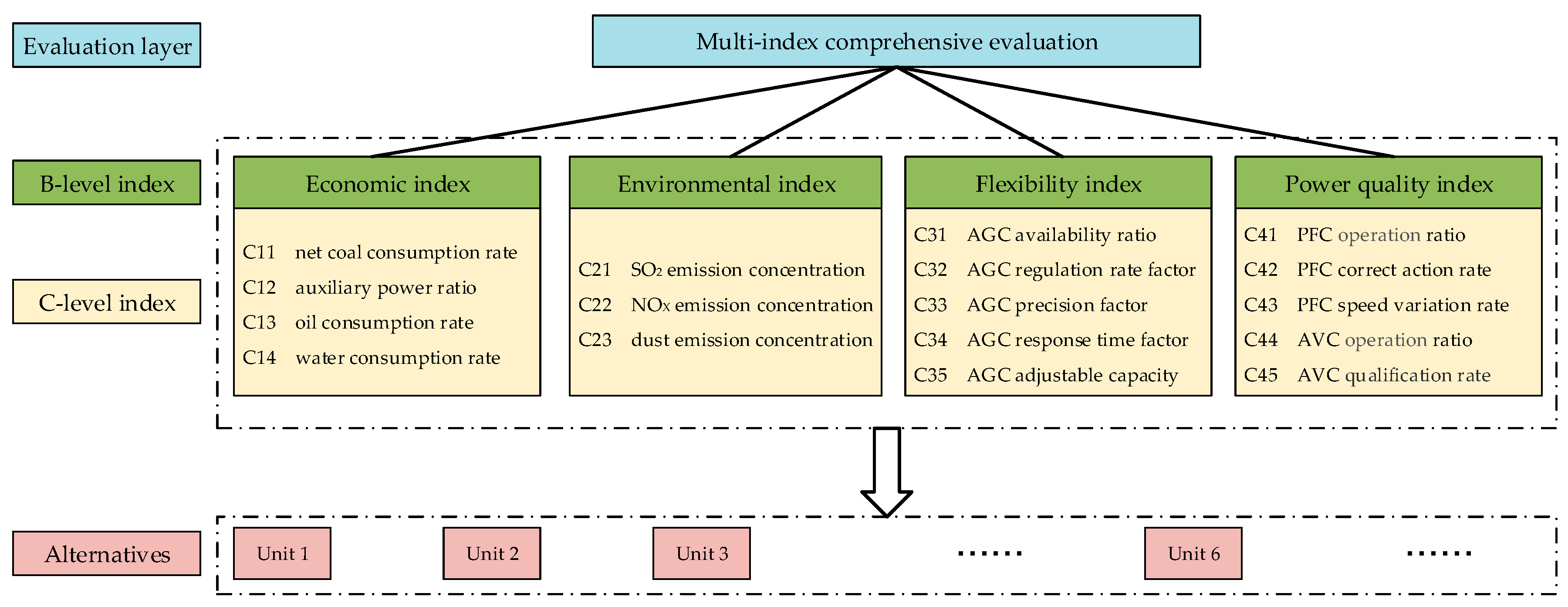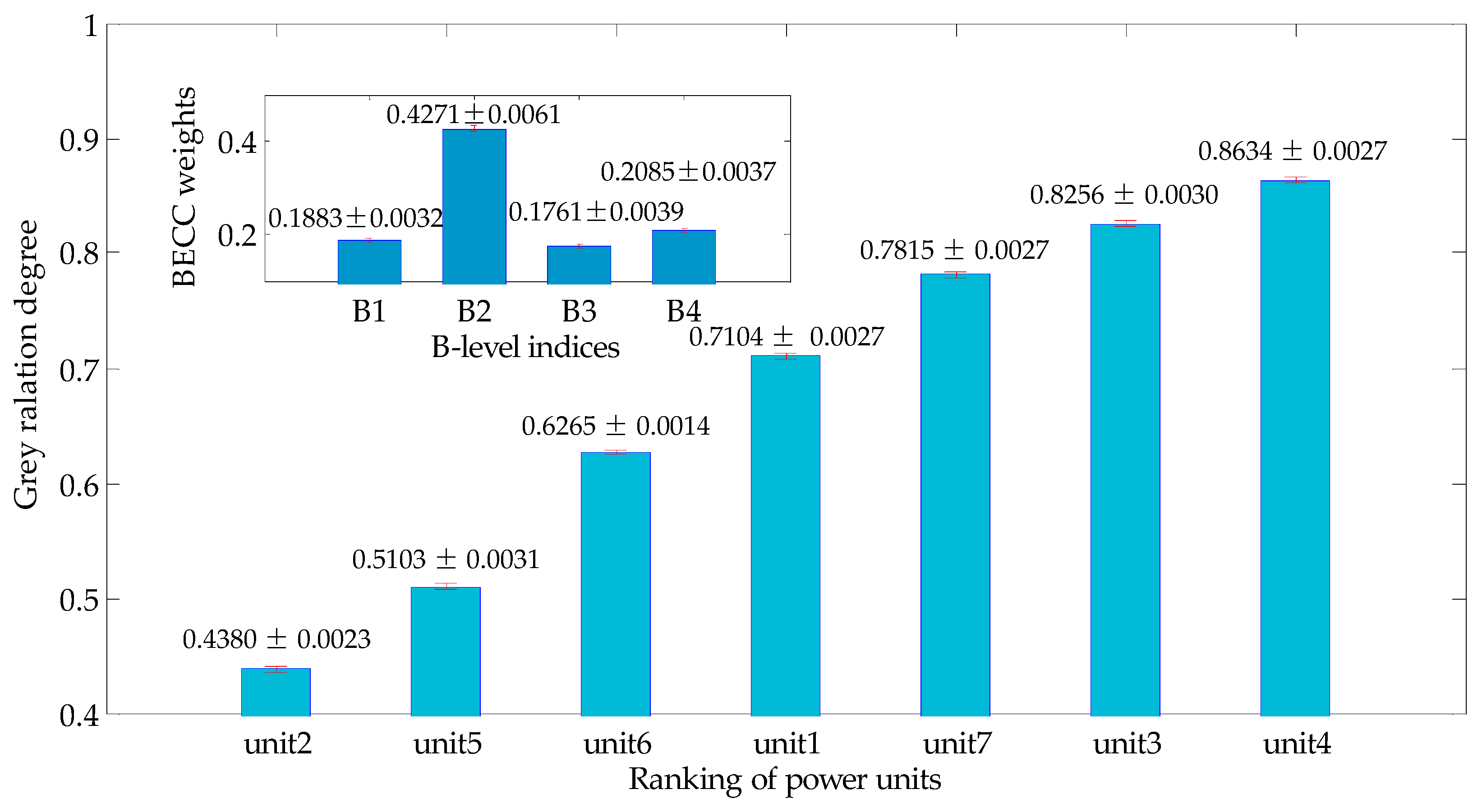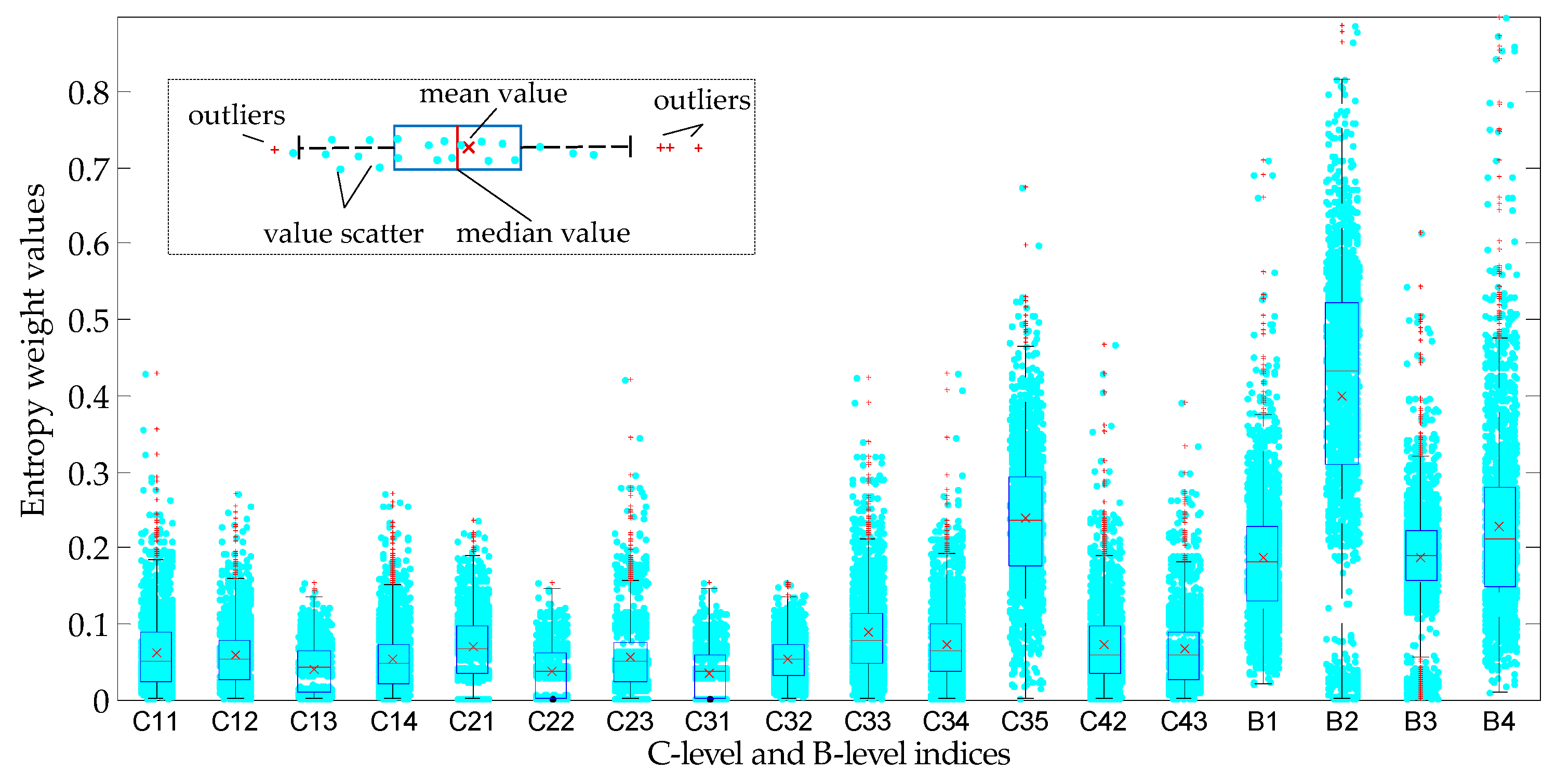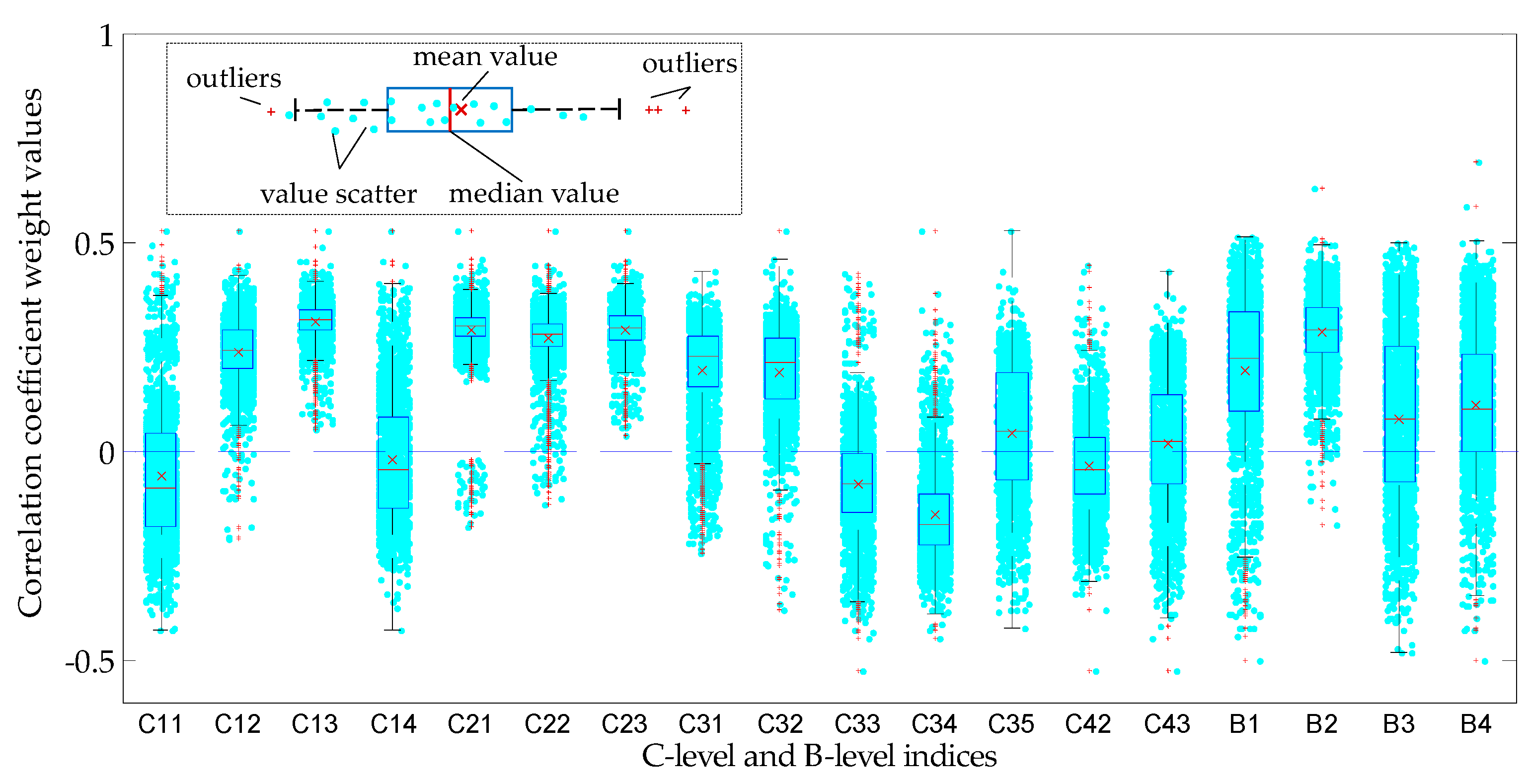4.1. Basic Information of Seven Power Units
This section conducts a comprehensive evaluation with the data of seven 600 MW subcritical coal-fired condensing power units in North China in the year 2016, which belong to the North China power grid. The detailed data we used are shown in
Table 3. The boiler of unit 1 and unit 2 have the design style of forced circulation and tangential combustion, and the other five boilers are natural circulation and opposed firing style. The fuel of the selected units is bitumite with the supply mode of straight blowing, and all the boilers are using plasma ignition mode. The design efficiencies of the boilers are 93.95% (units 1–2), 93.43% (units 3–4) and 94.36% (units 5–7), respectively. Correspondingly, the design heat consumption rates of steam turbine units are 7762 kJ/kWh (units 1–2), 7773 kJ/kWh (units 3–4) and 8153 kJ/kWh (units 5–7), respectively. The condensers of units 1–4 are cooled by water, and the rest by air.
All the units are equipped with a flue gas purification system, that is, a wet flue gas desulfurization (WFGD) system for SO2, selective catalytic reduction (SCR) system for NOX and electrostatic precipitator (ESP) for dust removal. To meet the demand of new ultra-lower emissions of China, these units had been further reformed except units 2 and 5. The reform measures include technologies such as low NOX combustion retrofit coupling with SCR, high-frequency power source retrofit of ESP system and the upgrading of desulfurization system, etc.
4.2. Evaluation Results
The comprehensive evaluation was carried out with the hybrid model introduced in
Section 3.3. The C-level data is nominalized with the index attribute information (see
Table 3), and the BECC weight of C-level indices are obtained listed as the last column in
Table 3. With the BECC weights of C-level integrating into the GRA evaluation process, we get the grey relational degree evaluation value vectors of each B-level indices, that is, economic index (B1), environmental index (B2), flexibility index (B3) and power quality index (B4). The four B-level result vector forms a new decision matrix, which is shown in
Table 4. The weights columns in
Table 4 are calculated based on the B-level decision matrix with the AHP and BECC method, and the combined weight also obtained with the two kinds of weights.
The evaluation result listed in
Table 4 shows that the economic performance (B1) of unit 4 is the best and unit 6 is the worst. While for the environmental protection performance (B2), the best one is unit 3 and the worst is unit 2. This is mainly because unit 2 has not been retrofitted with ultra-low emissions measures. The auxiliary energy consumption of environmental protection equipment of the units without ultra-low emission retrofit usually lower than the reformed one, and this will lead to a better economic performance. The flexibility index (B3) of unit 4 and unit 5 have little difference, which is higher than the others obviously, while unit 2 and unit 3 have the similar lower scores. And unit 6 has the best power quality performance, but unit 1 has the worst.
In order to decide the AHP weights of the four B-level indices, experts have been invited to developed pairwise comparison matrix until the consistency check is passed through. Then the AHP weight
is determined with the consistency ratio of 0.067. The AHP weight in
Table 4 reflects that the environmental protection index has attracted the most attention, mostly because of the deterioration of the environmental quality of China in recent years. Flexibility is the second important index of experts’ interested. As mentioned in
Section 1, this is closely related to rising proportion of renewable energy generation in the total power generation system. The economic index is the third and the power quality priority is the lowest.
The objective weight of BECC shows that it has an analogous priority with the AHP weight. The weight of environmental index in BECC is higher than the weight in AHP. However, the weight of flexibility index is the lowest one, which is incompatible with subjective experience. It also reflects that objective weight only based on the pure data is not an ideal way in sometimes and the subjective knowledge should be added in the evaluation process as an adjustment measure. The integrated weight calculated with Equation (21) shows that economic index and flexibility index are having similar value, while the environmental index is still the most important one. The priority of the integrated weight is in consist of AHP weight.
The final evaluation result, i.e., grey relational degree vector of B-level indices can be calculated with the B-level evaluation matrix, and the corresponding integrated weight is shown in
Table 4, which is calculated by the model introduced in
Section 3.3. The result is:
Finally, the ranking sequence of the evaluated power units based on the grey relational degree from large to small is as follows:
The result represents the comprehensive performance of power units with multiple evaluation criteria. The sorting result shows that unit 4 is the best one according to the proposed multi-level evaluation system. That means, for example, in an ESPGD situation with the seven competitive candidate coal-fired power units, unit 4 will gains the power generating right first.
The excellent performance of unit 4 is due to its economic index which is highest among the seven units, besides, the environmental index and flexibility index performance is higher than the other ones either in a large extent. Unit 2 is the worst one because of the environmental index value is too small, and at the same time, the weight of environmental factor is the most important among the B-level indices. With the similar reason of unit 2, the comprehensive performance of unit 5 is undesirable either, which is just a little better than unit 2.
It is clear that the proposed evaluation framework is different from the typical evaluation method which only considers the economic factor (mainly the net standard coal consumption). If the alternative units are assessed in a typical way, unit 2 is the best, and followed by unit 3, due to the outstanding performance of the net coal consumption rate (C11) index. It is obviously unreasonable in considering the environmental and other aspect evaluation indices. Thus, it is shown that the multi-index comprehensive evaluation is necessary.
The evaluation results also points out the retrofit direction of the units in improving comprehensive performance to achieve a higher score. Taking unit 5 for example, which is sorted as the sixth in the ranking list, the poor score mainly caused by the low performance of economic and environmental factors. However, in considering the flexibility criteria, the performance value is the best one due to the C35 index with a value of 55% adjustable power capacity. That means, if we want to improve the comprehensive performance of unit 5, the economic and environmental performance should be improved by the means such as energy saving retrofits or ultra-low emission reform.
The above discussion about the result shows that the comprehensive evaluation is reasonable and acceptable. The result can point out the weak part of the power generation operation and management of a unit, and the result may provide guidance for the promotion of operating performance.
4.3. Sensitivity Analysis Results
The final result of the proposed hybrid evaluation model will be varied when the weights with a possibility of uncertainty. In the process of determining combined weight in the B-level indices with AHP method, the expert preference was integrated as the subjective knowledge. However, the experience may vary with different experts, that means, the result got from the same evaluation model may be changed with different evaluation person. Thus, it is important to carry out weight sensitivity analysis in exploiting the latent evaluation information. Sensitivity results are shown in
Table 5 and
Table 6, with the analysis method mentioned in
Section 3.4.
From
Table 5, it can be found that the environmental performance (B2) and electricity quality index (B4) have an obvious effect on the evaluation results. The environmental indicator may lead to seven unit pairs with the inverse order, while the electricity quality may influence six pairs. However, the ranking results of some units are robust, i.e., the result will not be influenced by the B-level weight variation, such as (1,3), (1,4), (1,7), (2,3), (2,4), (3,6), (4,5) and (6,7).
Table 6 illustrated that the environmental performance indicator (B2) has a most sensitive performance, which means the B2 is the easiest indicator to change among the B-level indices. The flexibility indicator (B3) follows with the B2, while the economic index (B1) is the most robust one. The weight changing of index B1 and B2 will cause the raking of unit 5 inverse firstly, with units 2 and 6 respectively. While weight changes of B3 and B4 index bring ranking inverse with the same unit pairs (units 3 and 4).











